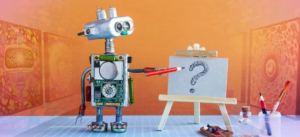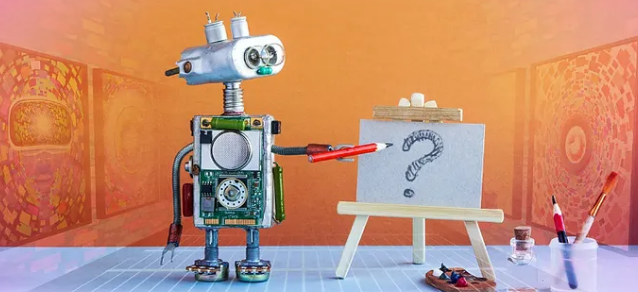AI and Art: Can Machines Really Be Creative?
Art has long been a peculiarly human activity-a creative marriage between the expresser, emotion, and imagination. Yet, with recent progress in the field of artificial intelligence, machines have increasingly grown adept at churning out works that in some ways seem to possess something almost like artistic panache. So, the question-Can AI be truly creative?-turns out to be a pretty interesting one. While AI can create impressive art, music, and poetry, according to many, real creativity requires much more than algorithms and data. Let’s explore some of the ways in which AI is rewriting the rules of the art world, why human and machine creativity differs, and what that means for the future of art.
1. The Rise of AI in Art Creation
Artificial intelligence-created art made quite the splash in recent years, with some selling at high prices through galleries and auctions. Among the most popular models of AI used in this kind of production, the most acclaimed are GANs: Generative Adversarial Networks. GANs consist of two neural networks: one that generates the images, while the other acts to evaluate the authenticity of the images. Through such feedback, the AI learns how to produce visuals much like those created by humans.
The best known perhaps is the portrait of Edmond de Belamy, created by an AI trained on thousands of historic portraits. A painting by a Paris-based art collective Obvious, it sold at Christie’s for more than $432,000 way back in 2018. That was the moment when AI crossed into the mainstream art world, raising debate over whether machines can be called artists.
2. AI in Music Composition: A New Soundscape
AI is not limited to the fine arts; music is no exception. Nowadays, we can have algorithms compose entire tracks with harmonies, melody, and emotional depth if needed. Some of the AI platforms that do this are Amper Music and AIVA, Artificial Intelligence Virtual Artist. These composers provide the ability for users to create various complex compositions using their preferred choices. Such AI composers have increasingly found applications in video music, advertisements, and online games where instant custom soundtracks are required.
However, while AI can create engaging music, many claim it lacks emotional depth and a storyline typical of human composition. Music describes many personal experiences and cultural contexts; these are things that machines can neither experience nor tell.
3. Writing and Storytelling: Can AI Come Up with Meaningful Narratives?
Meanwhile, it has also begun to write-whether poetry, journalism, or fiction. Language models, such as OpenAI’s GPT-3, can write stories, poems, and articles that seem incredibly coherent and engaging. These systems have been trained on huge swaths of text, which has allowed them to then mimic styles and produce content that reads well and appears human-made.
But AI doesn’t really understand the meanings of themes, emotions, or personal experiences that a writer puts into their work. Joy, heartbreak, and nostalgia-these aren’t ingredients which the artificial mind would experience; it cannot feel the very same feeling while telling stories. Therefore, though much writing by AI is always great, the depth of meaning that exists in literature just isn’t there in an AI’s output.
4. The Role of the Human Artist in AI-generated Art
When AI helps in creating art, one would wonder who the author is. While machines do the output, the human artist and the developers give the directions-from selecting the training data to refining algorithms. Most artists employ AI as a tool in collaboration with themselves to explore new forms of expression rather than replacement of traditional methods.
This relation between human and machine generally results in what is commonly called “co-creation,” where the AI creates for the artists by generating ideas, suggesting color schemes, or creating visual effects. From this perspective, the role of AI is more like that of a sophisticated brush or instrument rather than an independent artist.
5. Creativity: Human Intuition vs. Machine Algorithms
First, one needs to define creativity. Creativity refers not only to producing something new and original but also filling it with meaning, purpose, and intention. A great deal of human creativity is rooted in experiences, emotions, and abstract thinking-qualities that machines cannot wholly replicate.
By contrast, AI creates “creativity” only in so far as it is able to recognize and re-pool patterns that exist in big datasets. Results are very often amazing, but quite different from intuitive leaps or personal insight, which is a hallmark of human creativity. Machines lack the self-awareness or reflective capacity about their creations that so many think is essential to artistry.
6. Ethics of AIs’ Artistic Role
Another set of issues surrounds new technology for AI-generated art. Who owns a copyright in an artwork when it has been generated by a machine? Does the AI work have inherent value, or is it more of a byproduct of the code and data which produced it? These questions are not only theoretical: if AI-generated art really happens, whole industries might fall apart, thereby affecting the livelihoods of artists, musicians, and writers.
Some believe AI-generated art devalues human creativity, rather than any reflection of the human experience, by making it completely a product of algorithms. Others see it as a democratization of creativity for people who are not formally trained to explore and produce art.
7. Embracing AI as a Tool for Inspiration and Innovation
AI is, for so many artists, a strong enabler of artistic expression. Liberated from the drudgery and time wasted doing repetitive tasks, coming up with new ideas, or doing those which are difficult in technique, AI lets an artist focus on conceptual and interpretive aspects. In this manner, AI does not replace human creativity; it simply enhances it to expand what art can be.
Generative AI tools can inspire original visions in artists, challenging conventional methodologies. For example, Google’s DeepDream lets one explore dream and surreal imagery that is hardly conceivable to be designed by human hand. The collaboration between human vision and machine algorithms shows how AI opens new frontiers of creativity.
8. The Future of AI and Art: Blending Machine Innovation with Human Emotion
As AI continues to develop, the lines drawn between human and machine creativity will become increasingly blurred. We will also see more and more artists use AI as a medium, fusing machine-generated patterns with human emotions and narratives into hybrid forms of art. Such a combination of machine innovation and human emotion could, indeed, expand our notion of creativity, thus allowing us to fully appreciate the rich contributions made possible by both human and AI.
But as we construct algorithms that are better at understanding human emotions, the potential for even more sophisticated and emotionally resonant art could exist in future AI systems. But will this make AI more creative-or just better at assisting human artists in their own creativity?
Conclusion: Can AI Be Creative?
Whereas AI can certainly produce impressive and original works, its form of “creativity” differs from that deeply personal and intuitive process which characterizes human art. AI lacks lived experiences, emotional insight, and self-reflection, deemed essential for so many in the creative process. However, AI can indeed serve as an invaluable tool for artists in generating new ideas, pushing boundaries, and extending new modes of expression.
As we keep pushing the boundaries of AI in art, we realize that AI is complementary rather than a replacement for human creativity. The future of art might be less about choosing between humans and machines but embracing the peculiar possibilities arising due to collaboration between them.

Also Read :
- From Chatbots to Companions: How AI is Evolving Communication
- AI in Our Everyday Lives: More Than Just Robots
- The Rise of AI: A New Industrial Revolution?
- Geothermal Energy: Unlocking the Earth’s Heat for a Sustainable Future
- The Rise of Solar Skins: Aesthetic Solar Panels for Urban Sustainability
